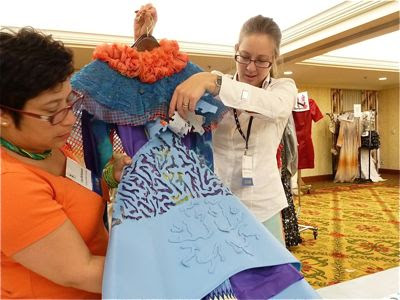Lisa McRoberts, from Louisiana, shows "Tropical Paradise," one of the pieces entered in the category of Hawaiian-inspired garment design in the International Textile and Apparel Association's Creative Design Awards.
Five hundred members of the International Textile and Apparel Association have descended upon Honolulu for the organization's annual conference, highlighted by a series of fashion shows and academic presentations that began Nov. 14 and continues through Saturday.
Alas, attendence is open only to ITAA members, an association of professors involved in the apparel industry.
Conference co-chairs Andy Reilly, from the University of Hawaii's APDM program, and Linda Bradley, of Washington State University's Apparel, Merchandising, Design & Textiles program, were instrumental in laying the groundwork for the conference, featuring dozens of speakers, including Josh Feldman, president and CEO of Tori Richard, one of the keynote speakers.
It's great that they are able to come here and examine what's going on in Hawaii, while presenting informative workshops that allow those in the industry to get a feel of innovations elsewhere.
McRoberts and Linda Ohrn-McDaniel of Kent State University show an undergraduate student's work, "Coral Reef," utilizing vinyl with cutwork and machine-made lace with a jersey knit bodysuit.
Workshops include use and application of the sustainable apparel index, geared toward reducing environmental and social impacts of apparel and footwear products; impact of United States imports from China; an examination of the price of Levi's jeans across countries; functional/protective apparel design; and much more.
I was lucky enough to be invited to be a judge in the ITAA's Creative Design Awards. Judging took place Nov. 14 at the Marriott Waikiki Beach Resort & Spa, where designer Jeannie Chun, Hifi co-founder Toby Portner and I faced the daunting task of choosing from among 136 incredible designs. It turned out to be a four-and-a-half hour task, that went that quickly because we were in agreement in most cases. At times, our criticisms as the garments were presented made if feel like "Project Runway." The intricacy of the designs, the handwork, and thought process behind many of the works wowed us.
Judging was blind, so we don't know the identities of the undergraduates, graduate students and faculty members who created the designs, although I recognized some of the designs created by UH students.
There were many pieces we said we wished we could keep, and contest organizer Linda Ohrn-McDaniel, an associate professor at Kent State University, suggested talking to the designers after the fashion show and awards ceremony taking place Friday night at the Marriott. We had to do our judging based on presentation of the garments and photos of the designs on models or manikins. The show will be our only opportunity to see how the garments move and wear on the runway. I'm looking forward to it and will be shooting video for those who can't be there.
For more information, visit http://www.itaaonline.org/
Photos courtesy ITAA
All the judges loved this "Mountain, Cloud and Portrait of a Beauty" Korean-inspired bias-cut dress of naturally dyed raw silk and ramie, entered in the fiber arts professional category. The blue pieces were hand-sewn using gamchimjil, similar to overcast stitch, typically used in Korean quilting, with handpainting.
Photos courtesy ITAA
Everyone from Gwen Stefani to Victoria's Secret have run afoul of Native Americans for their misinterpretation and misappropriation of culture, but we loved this diamond pattern woven tube dress with fringed hem and corset back, and wrap, inspired by Native American hand-weaving.
"CoVess" is a graduate student work comprising material made of repurposed felt waste.
Fellow judge Toby Portner holds up two of our favorite designs in the Professional Awards category. One is a dress made by recycling camouflage jackets and pants. The other is an exquisite digital printed linen jacket.
Prior to judging, designer Jeannie Chun inspects garments on the racks. This "Circles" dress was created by a graduate student.
An undergraduate student created this wood dress also incorporating cotton muslin, with detail of the wood slices, below.
I was intrigued by this dramatic "Earth Warrior" sweater and bodysuit ensemble inspired by samurai armor, created by an undergraduate student. The description below also shows what it looks like on the body.
An impeccable mod suit, created by a graduate student, paired with a beautiful sheer blouse with pleated yoke.
"Impressions in Hawaii" gives the impression of a lava flow. It looks similar to one of Christian Siriano's gowns from two springs ago.
This Hawaiian category sweater was inspired by both the feather capes of the ali 'i, and the capes worn by early missionaries to Hawaii.
We appreciated all the work that went into this entry into the Professional category Hawaiian-inspired garment design competition. The top shows the original digital print fabric, a fusion of the colors of the ohelo flower. The skirt comprises the same fabric, cut into strips and woven to create more texture.
This is an undergraduate student's conversation-starting look-at-me dress, that appears as a simple sheath in the front, with a surprise back.
I have a silver-and-black M Missoni dress that, from a distance, looks like this undergraduate "Uncaged" dress, but this dress was so much more detailed, with yarn and pieces of recycled felted sweaters used to construct metallic-wired cage overlay. It also came with a bird handbag made with wool scraps.
"Eco-Pop," created by one of the faculty professionals, comprises spray-painted aluminum can tabs over a rayon shell in a dress inspired by Vasily Kandinsky's 1926 painting, "Several Circles." It took five years to amass the tabs.
Similarly, this bodice was created from 1,200 pop caps and tabs. We might have liked it better if the skirt comprised something other than trash bags. Seen it too many times.




















No comments:
Post a Comment